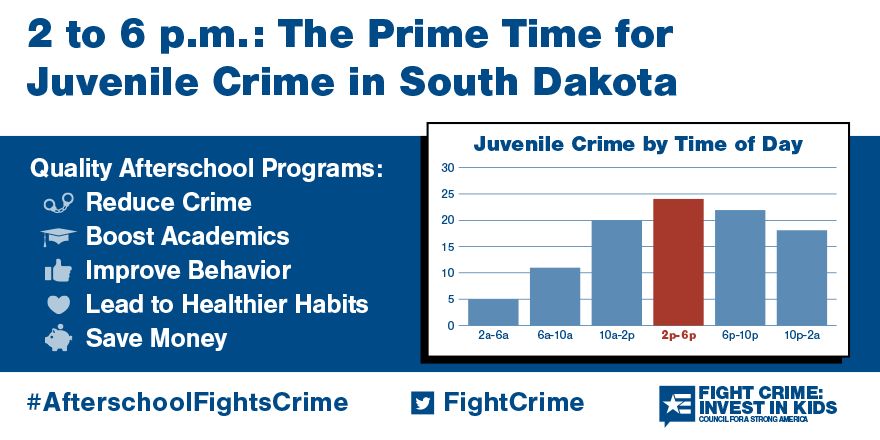After School: Still the Prime Time for Juvenile Crime in South Dakota
Afterschool Fights Crime in South Dakota
Related
The more than 5,000 law enforcement leaders around the nation who are members of Fight Crime: Invest in Kids, have long known that the hours immediately after school lets out, when parents are likely not available to supervise, are the prime time for juvenile crime. Over the past 20 years, law enforcement leaders across the country have relied on high-quality afterschool programs to provide supportive, stable, and enriching environments with caring adults that keep children and youth out of trouble and safe, while supporting their academic success, and social and emotional development.
The Prime Time for Juvenile Crime in South Dakota

In South Dakota, juvenile crime peaks between 2-6 p.m. on school days, with about 24 percent of all juvenile crime on those days occurring during the hours following the last school bell.
Program Highlight: Boys & Girls Clubs, Sioux Falls
Central to the mission of the Boys & Girls Clubs of the Sioux Empire is building strong relationships between adult mentors and young people to create an environment where young people feel safe and supported. The organization serves more than 1,800 children from 4 weeks to 18 years across 10 sites in Sioux Falls, South Dakota—with approximately 1,400 students in elementary, middle, and high school. Through the Boys & Girls Clubs of the Sioux Empire’s afterschool programs, students receive a healthy snack and one-on-one tutoring, as well as access to a STEM lab, an arts studio, a workforce education center, and a recreation space. Programming runs the gamut, from performing arts to a “fix-it” club, where students have worked on repairing a popcorn machine that was then donated to the organization.
Programming also addresses troubles and hardships that students in the program face, providing one-on-one counseling services, an opioid prevention program called Positive Action, and Youth for Unity—a space that brings together students, families, and outside partners to discuss culture, empathy, tolerance, and acceptance. Through the Juvenile Justice Delinquency Prevention Mentoring Program, an Office of Juvenile Justice and Delinquency Prevention grant, the organization is able to maintain low student-to-staff ratios to provide students with the individualized attention that they need. The program also works to build positive relationships between youth in the program and local law enforcement, bringing in community police officers once a week to meet and engage with students in a positive setting. In the most recent survey of students, the program found that 89 percent of students reported that they feel safe in the program and 89 percent said that they feel respected by their peers.
Download the Graphic
Read More About
States
